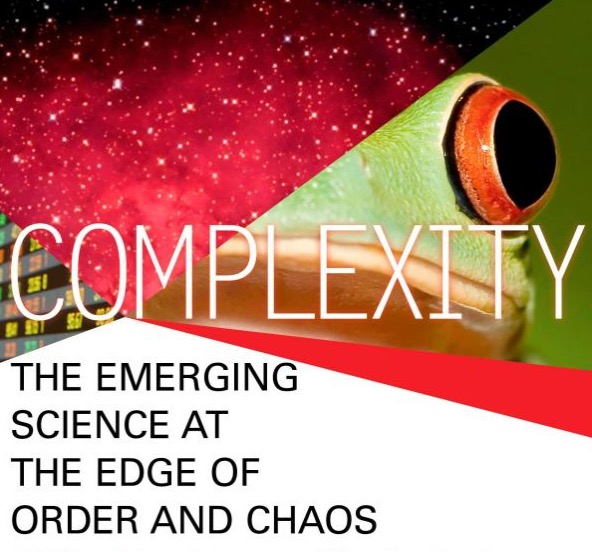
Complexity is a big deal in PLM. Because all PLM systems available today in the market are crazy complex. Talk to anyone in PLM industry and they will tell you that to wrap your head around PLM system concepts and objects can make your head hurt. This year, I will have an opportunity to discuss complexity and PLM at COFES. Because complexity and transformation is a theme for COFES 2017. I’ve got a reminder about COFES 2017 in my mail – a book by M. Mitchell Waldrop – Complexity: The Emerging Science at the Edge of Order and Chaos. Here is a passage I captured from COFES 2017 website:
This year at COFES 2017, we’ll take a deep dive into complexity and transformation. The growth of complexity in everything we do is presenting us with new and difficult challenges, from our constantly changing business environment, to conflicting requirements of more simplicity (to the customer) in products that require more complexity to deliver. New phenomena result from complexity, often requiring consideration of things that were not previously an issue. The demands of IoT, the emergence of additive manufacturing. And it’s not just products: emergent properties of complexity occur in processes, in IT, in business models, in politics, and in economies. Rather than focus on how to design complex systems from scratch, our attention will be on interventions that can transform existing systems to mitigate the effects of complexity.
You can read some of my articles related to PLM and Complexity here. Back in 2012, Gartner Research outlined 10 Consumer Macro Trends to Impact Technology, Media and Service Providers for Next 10 Years. And here it is – No.9 in the list:
Market Trend No. 9 — The Death of Complexity. The consumer market is becoming progressively less tolerant of complexity. Although consumers tend to buy products with ever-richer features, they often prefer those that are simple and intuitive. The ability to provide appealing and intuitive user interfaces has become a critical point of differentiation among competing technology providers. As technology becomes more complex, vendors need to invest more in keeping the user interface simple and intuitive. T&SPs therefore need to focus on simplifying technology, pricing, brand messaging, and feedback and interaction, and consider offering chargeable help services for consumers challenged by installing and configuring new equipment and services in their homes.
In my view, to fight complexity is one of the most important imperative in enterprise software and PLM specifically – PLM and the death of complexity. Check another article I posted last year – Hard things about simple PLM. One of my favorite researches John Gall introduce Gall’s law about complexity in his book – Systemantics: How Systems Work and Especially How They Fail.
Gall’s Law states: A complex system that works is invariably found to have evolved from a simple system that worked. A complex system designed from scratch never works and cannot be patched up to make it work. You have to start over with a working simple system. – John Gall (1975, p.71)
This law is essentially an argument in favor of under specification: it can be used to explain the success of systems like the World Wide Web and Blogosphere, which grew from simple to complex systems incrementally, and the failure of systems like CORBA, which began with complex specifications. Gall’s Law has strong affinities to the practice of agile software development.[8]
So, here is the things – all PLM systems were designed and built “top down” for a specific complex situations – aerospace and defense OEMs, automotive companies and complex industrial machinery manufacturers. There are good reasons for that – by building a complex PLM system you’re capable to attract large businesses that eventually can pay you top dollars. But John Gall’s law says, an attempt to build a complex system top down never works and cannot be patched up to make it work. It sounds like “catch 22” – PLM companies are building complex PLM systems to attract large companies and then trying to patch them to work. What else, all these systems can hardly scale down to serve large community of SME manufacturing companies.
What is my conclusion? There is a significant number of PLM implementation for large companies – top OEMs in aerospace, defense, automotive and other industries. These systems are complex and most of them today are struggling to transform into agile services to adapt manufacturing transformation and global manufacturing ecosystem. Companies are challenged to keep these systems operating as well as to support new business requirements. Manufacturing are paying top dollars to make it happen. The transformation of these systems will be a strategic goal for PLM vendors and industry in coming decade. Just my thoughts…
Best, Oleg
P.S. COFES 2017 is 6-9 April in Scottsdale, AZ. If you want to come to COFES, apply for the invitation here.
Want to learn more about PLM? Check out my new PLM Book website.
Disclaimer: I’m co-founder and CEO of openBoM developing cloud based bill of materials and inventory management tool for manufacturing companies, hardware startups and supply chain. My opinion can be unintentionally biased
Disclaimer 2. COFES didn’t pay me to write this article.
The post PLM Complexity and Future Transformation appeared first on Beyond PLM (Product Lifecycle Management) Blog.


Be the first to post a comment.